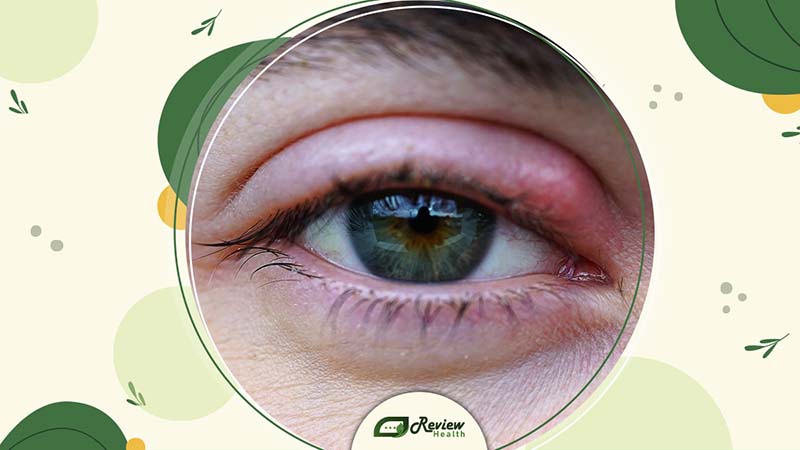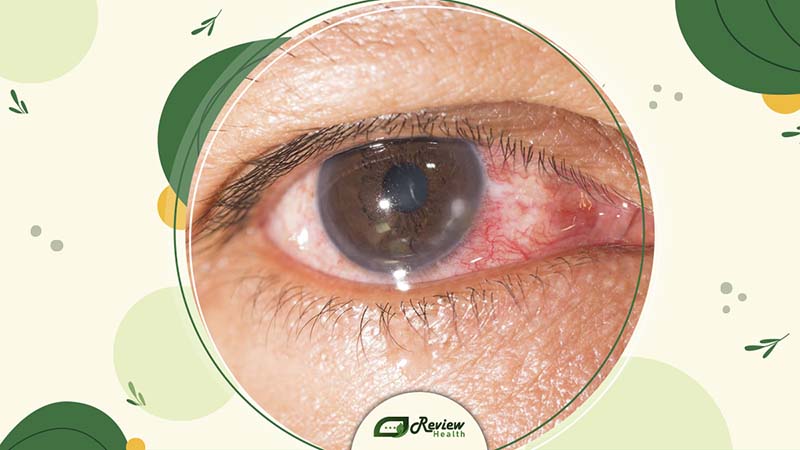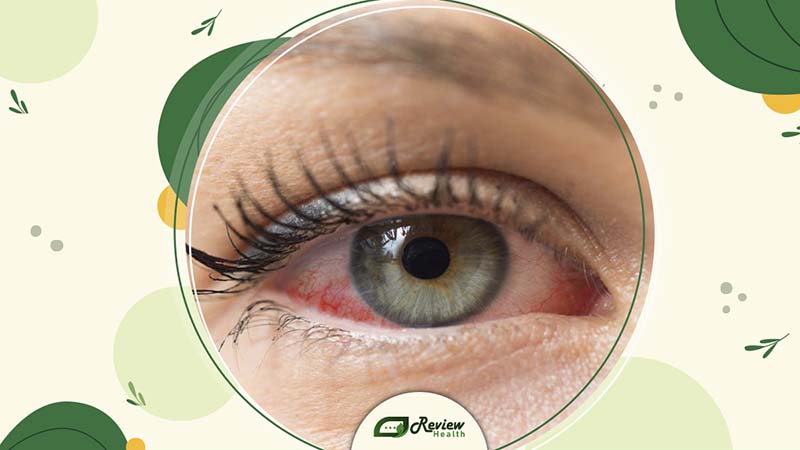What is commonly misdiagnosed as pink eye? Annually, conjunctivitis—commonly referred to as pink eye—impacts approximately 6 million individuals. The primary symptoms, which include redness, itching, and a gooey discharge, are also typical of several other ocular disorders. Consequently, it’s not uncommon for various eye conditions to be mistakenly identified as pink eye. In this Review Health article, we will explore some of these frequently confused eye ailments.
What Is Pink Eye? Overview of Pink Eye
The conjunctiva is a thin, clear layer that covers the front of the eyeball and the inside of the eyelids. It produces mucus and tears to keep the eye moist and protect against outside irritants and germs.
When the conjunctiva gets inflamed, the white part of the eye (sclera) looks pink or red, which is why the condition is called pink eye, or conjunctivitis. Most pink eye cases are caused by viral or bacterial infections, but it can also come from irritation or injury to the eye.

Identifying the Signs of Pink Eye
Pink eye symptoms can vary based on whether the cause is bacterial, viral, or allergic. Common signs include:
- Redness
- A gritty feeling, as if something is in your eye
- Itchiness
- Burning sensation
- Swollen eyelids
- Watery eyes or discharge
- Blurry vision
- Sensitivity to light
- Mild pain
These symptoms help distinguish the type of pink eye and guide appropriate treatment.
What is commonly misdiagnosed as pink eye ?
Eye redness, irritation, and discharge are classic symptoms of pink eye, but these symptoms can also appear in other eye conditions.
Hordeolum (Stye)
A stye typically forms along the eyelashes and may occasionally occur inside your eyelid. Known for its red, painful bump that resembles a pimple, a stye can also cause eyelid swelling.

Blepharitis
This condition involves inflammation of the eyelids. Blepharitis is characterized by swollen eyelids and symptoms of dryness, and unlike pink eye, it may produce foamy tears.
Keratitis
Inflammation of the cornea, known as keratitis, shares many symptoms with pink eye but tends to be more painful.

Iritis or Uveitis
Uveitis refers to inflammation inside the eye due to certain cancers, autoimmune diseases, or infections. Iritis is a type of uveitis called anterior uveitis. Uveitis can cause floaters or dark spots in your vision, and increased sensitivity to light if the inflammation is in the front of the eye.
Glaucoma
A degenerative disease affecting the optic nerve, glaucoma typically does not cause symptoms in its early stages but can lead to vision issues later. Unlike pink eye, glaucoma does not cause redness or discharge.
Allergies
Allergic reactions can cause eye redness, consistent itchiness, and possibly watery eyes, but they usually don’t produce the same type of discharge as pink eye.
Dry Eye
Dry eye syndrome, resulting from insufficient tear production, shares many symptoms with pink eye but also causes a stinging sensation. Dry eye is usually chronic, whereas pink eye develops suddenly.

Find out more: Dry Eye Syndrome Treatments: Quick Relief Tips
Episcleritis
This condition involves inflammation of the episclera, a layer atop the white part of the eye. While it causes redness and pain, episcleritis rarely leads to vision problems or discharge.
Corneal Abrasion
Caused by scratches to the cornea, typically from foreign objects like sand, a corneal abrasion can lead to mild to severe pain and vision changes.
Chalazion
A chalazion is a swollen bump on the eyelid that can cause extensive swelling and tenderness of the eyelid.
Scleritis
Inflammation of the sclera, or the white part of the eye, scleritis can cause pain extending to the jaw and other facial areas. It often occurs in just one eye and typically does not produce thick discharge like pink eye.
Learn Why Other Conditions Are Often Misdiagnosed as Pink Eye
Other eye diseases are frequently mistaken for pink eye, or conjunctivitis, mainly because many eye conditions share similar symptoms. Conjunctivitis is marked by eye redness, swelling, itching, and discharge—common signs that are not exclusive to this condition. For example, ailments like blepharitis (inflammation of the eyelids), dry eye syndrome, or corneal ulcers also display these symptoms, leading to possible misdiagnoses.
The causes of pink eye, such as viruses, bacteria, allergies, or irritants, are also common triggers for other eye issues, adding to the diagnostic confusion. Allergic reactions might cause both allergic conjunctivitis and allergic blepharitis, complicating the differentiation for non-specialists based on symptoms alone.
Diagnostic practices can also make it difficult to correctly identify the condition. Pink eye is often diagnosed through clinical observation rather than precise laboratory tests. This method can cause other conditions to be overlooked if the initial symptoms seem to point to conjunctivitis. Without specific tests, it’s hard to distinguish between various eye ailments.
Moreover, the prevalence of pink eye leads to its frequent misdiagnosis. It’s one of the most well-known eye conditions, leading healthcare providers and patients to quickly assume its presence when typical symptoms like eye discomfort or redness appear. This familiarity might discourage a more detailed examination of less common eye disorders that require different treatments.
Lastly, public awareness influences these diagnostic errors. Since pink eye is widely recognized compared to other eye diseases, people often self-diagnose based on their understanding of the symptoms, which highlights the necessity of consulting healthcare professionals for a proper diagnosis and suitable treatment when eye symptoms occur.
Preventive Measures for Eye Health
To maintain good eye health, several proactive steps are essential. Regular eye exams are crucial, especially for those over 60 or at a higher risk for eye diseases. A comprehensive dilated eye exam allows eye care specialists to check the macula, retina, and optic nerve for any signs of damage or disease.
Eating a diet rich in fruits and vegetables, especially dark leafy greens, supports eye health. These foods are high in antioxidants like lutein and zeaxanthin, which can help prevent cataracts. Additionally, fish that are sources of omega-3 fatty acids, such as salmon, halibut, mackerel, sardines, and tuna, are beneficial for the eyes.

Maintaining a healthy weight is vital, as being overweight increases the risk of conditions that could lead to vision loss. A combination of regular exercise and a balanced diet can help mitigate these risks.
Wearing sunglasses that block 99-100% of UVA and UVB rays is crucial to protect your eyes from harmful UV radiation, reducing the risk of conditions like cataracts, eye sunburn, cancers, and growths.
Taking breaks from screens and reading can help prevent digital eye strain and myopia, which affects distance vision. The 20-20-20 rule—looking at something 20 feet away for 20 seconds every 20 minutes—is a helpful practice to adopt.
Regular physical activity helps promote healthy blood vessels, lowering the risk of glaucoma and diabetic retinopathy.

Quitting smoking is also imperative as it reduces the risk of severe eye conditions such as macular degeneration and cataracts.
Lastly, always wear appropriate protective eyewear, such as safety glasses or goggles, when involved in activities with risks of eye injuries, including sports or working with hazardous materials. This simple step can prevent many potential eye injuries.
Please Consult Your Doctor About Pink Eye: When Is It Necessary?
See a doctor if:
- Your symptoms don’t show signs of improvement after a few days.
- You exhibit symptoms indicative of an eye infection.
- You’ve suffered an eye injury.
- Your symptoms appear to be linked to a chronic medical condition, like an autoimmune disease.
Conclusion
Redness, blurriness, and watery eyes are symptoms that might suggest pink eye, but they can also be indicative of other health conditions. To ensure you receive the correct diagnosis and appropriate treatment, it’s important to consult with a healthcare professional. What is commonly misdiagnosed as pink eye? Understanding the true underlying cause of these symptoms is crucial. In the realm of Review Health, accurate diagnosis is paramount.

